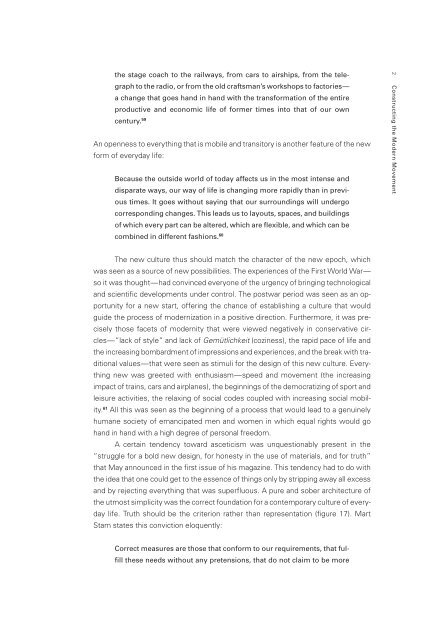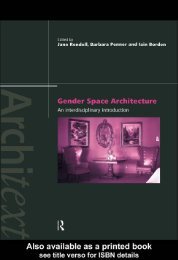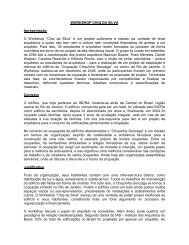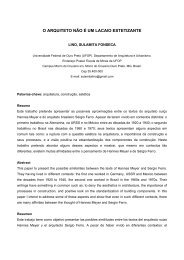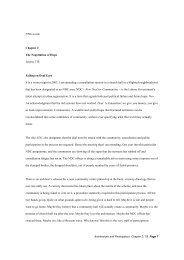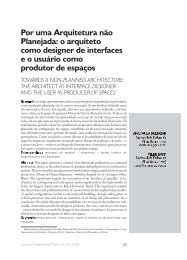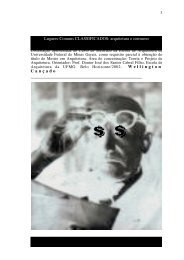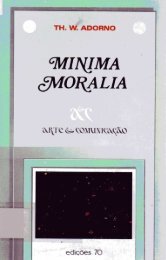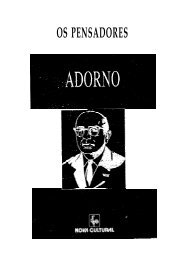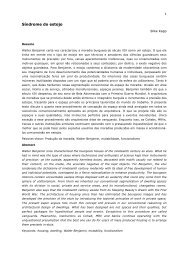Architecture and Modernity : A Critique
Architecture and Modernity : A Critique
Architecture and Modernity : A Critique
You also want an ePaper? Increase the reach of your titles
YUMPU automatically turns print PDFs into web optimized ePapers that Google loves.
the stage coach to the railways, from cars to airships, from the telegraph<br />
to the radio, or from the old craftsman’s workshops to factories—<br />
a change that goes h<strong>and</strong> in h<strong>and</strong> with the transformation of the entire<br />
productive <strong>and</strong> economic life of former times into that of our own<br />
century. 59<br />
An openness to everything that is mobile <strong>and</strong> transitory is another feature of the new<br />
form of everyday life:<br />
Because the outside world of today affects us in the most intense <strong>and</strong><br />
disparate ways, our way of life is changing more rapidly than in previous<br />
times. It goes without saying that our surroundings will undergo<br />
corresponding changes. This leads us to layouts, spaces, <strong>and</strong> buildings<br />
of which every part can be altered, which are flexible, <strong>and</strong> which can be<br />
combined in different fashions. 60<br />
The new culture thus should match the character of the new epoch, which<br />
was seen as a source of new possibilities. The experiences of the First World War—<br />
so it was thought—had convinced everyone of the urgency of bringing technological<br />
<strong>and</strong> scientific developments under control. The postwar period was seen as an opportunity<br />
for a new start, offering the chance of establishing a culture that would<br />
guide the process of modernization in a positive direction. Furthermore, it was precisely<br />
those facets of modernity that were viewed negatively in conservative circles—”lack<br />
of style” <strong>and</strong> lack of Gemütlichkeit (coziness), the rapid pace of life <strong>and</strong><br />
the increasing bombardment of impressions <strong>and</strong> experiences, <strong>and</strong> the break with traditional<br />
values—that were seen as stimuli for the design of this new culture. Everything<br />
new was greeted with enthusiasm—speed <strong>and</strong> movement (the increasing<br />
impact of trains, cars <strong>and</strong> airplanes), the beginnings of the democratizing of sport <strong>and</strong><br />
leisure activities, the relaxing of social codes coupled with increasing social mobility.<br />
61 All this was seen as the beginning of a process that would lead to a genuinely<br />
humane society of emancipated men <strong>and</strong> women in which equal rights would go<br />
h<strong>and</strong> in h<strong>and</strong> with a high degree of personal freedom.<br />
A certain tendency toward asceticism was unquestionably present in the<br />
“struggle for a bold new design, for honesty in the use of materials, <strong>and</strong> for truth”<br />
that May announced in the first issue of his magazine. This tendency had to do with<br />
the idea that one could get to the essence of things only by stripping away all excess<br />
<strong>and</strong> by rejecting everything that was superfluous. A pure <strong>and</strong> sober architecture of<br />
the utmost simplicity was the correct foundation for a contemporary culture of everyday<br />
life. Truth should be the criterion rather than representation (figure 17). Mart<br />
Stam states this conviction eloquently:<br />
Correct measures are those that conform to our requirements, that fulfill<br />
these needs without any pretensions, that do not claim to be more<br />
2 Constructing the Modern Movement


